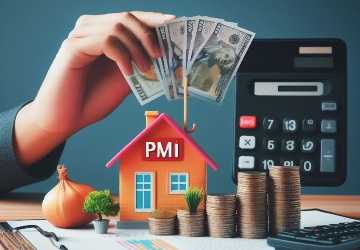Understanding Private Mortgage Insurance (PMI) and How to Avoid It
Frustrated by PMI costs? Learn what PMI is and how to avoid it. Our guide explains strategies to eliminate this extra expense, helping you save on your mortgage!
Buying a home is exciting, but unexpected costs like Private Mortgage Insurance (PMI) can make your dream a financial headache. Many homebuyers are caught off guard by PMI, which can add hundreds to their monthly payments.
Imagine finding your perfect home, only to discover that this extra expense throws your budget off. PMI can make an affordable home suddenly feel out of reach, forcing tough financial decisions.
While PMI can be frustrating, it's not impossible to handle. With the proper knowledge, you can avoid or minimize its impact. This article will demystify PMI, explaining what it is, why lenders require it, and how you can sidestep this cost.
Ready to take control of your home-buying journey and save money? Let's keep reading the blog post!
The Importance of Understanding PMI
Let's discuss why understanding Private Mortgage Insurance (PMI) is essential. You need to understand this if you're in the market for a new home.
PMI is like an insurance policy, but not for you. It's for your lender. PMI protects the lender if you can't keep up with your mortgage payments and default. Sounds great for them, right? But here's the kicker: you're footing the bill for this insurance.

You might be thinking, "Wait a minute, I'm paying extra monthly to protect the bank?" Yep, that's precisely it. Those extra costs can add up over time, potentially taking a big bite out of your budget.
If you know what you're dealing with, you can often find ways to dodge PMI altogether. And that can mean some serious savings. Yes, we're talking thousands of dollars over the life of your loan. That money could be going toward home improvements, your kids' college fund, or that dream vacation you've been putting off.
By getting clued up on PMI, you're setting yourself up to make smarter house-hunting choices. You can plan your finances better and negotiate a better deal.
So, take the time to understand PMI. It might not be the most exciting topic, but trust me, your future self (and wallet) will thank you.
Why Do Lenders Require PMI?
From a lender's perspective, PMI is like a financial safety blanket. If you're only putting down a small amount, they're taking an enormous gamble on you. PMI helps them sleep better at night, knowing they're covered if things go south.
It's a mixed bag for you, the borrower. On the downside, it means higher monthly payments. But on the flip side, it allows you to buy a home without saving up for years to make a massive down payment. It's a trade-off; whether it's worth it depends on your situation.
How to Avoid PMI?
Now, here's the good stuff: how to dodge PMI altogether. The most straightforward way? Save up for that 20% down payment. It's not easy, but it's a surefire way to avoid PMI. On a $300,000 home, that means putting down $60,000. Ouch, right?
If that's not feasible, don't worry. There are other tricks up your sleeve. One option is a piggyback loan, also known as an 80-10-10 loan. You take out a primary mortgage for 80% of the home's value, a second mortgage for 10%, and put down the remaining 10%. It's more complex but can help you sidestep PMI.
Some lenders offer Lender-Paid Mortgage Insurance (LPMI). They cover the PMI cost in exchange for a slightly higher interest rate. It sounds good, but do the math to ensure it saves you money in the long run.
Lastly, look into government loans. A VA loan could be your ticket to avoiding PMI if you're a veteran. Depending on your circumstances, there are other options, too.
Lastly, look into government loans. If you're a veteran, a VA loan could be your ticket to avoiding PMI. Depending on your circumstances, there are other options, too.
Remember, avoiding PMI isn't always the best move. Sometimes, it might make sense to pay PMI if it means getting into a home sooner. It's all about weighing your options and determining what works best for your financial situation.
Take Control of Your Mortgage Costs
When you understand PMI, this often overlooked cost could save you thousands over the life of your mortgage. That's not pocket change; it's real money that could fund home improvements, your kids' education, or that dream vacation.
So, what's your next move? It may be time to reevaluate your savings strategy to reach that 20% down payment. You may also need to explore those alternative loan options we discussed.
Don't let PMI blindside you when you're house hunting. Get ahead of the game now. Talk to lenders, crunch the numbers, and determine what works best.
Remember, every dollar counts when buying a home. Take control of your mortgage costs. Your dream home is waiting, and with the right approach, you can make it yours without breaking the bank on PMI.

Frequently Asked Questions
Q. What happens to PMI if I default on my loan?
Ans. If you default on your mortgage, PMI doesn't save you. It's there for the lender. Think of it as the lender's safety net. If you can't keep up with payments and the bank has to foreclose, PMI will cover some of their losses. It's like insurance for them, not you.
Q. Can I remove PMI after paying down my mortgage?
Ans. You're not stuck with PMI forever! Once you've built up 20% equity in your home, you can ask your lender to drop the PMI.
Q. Is PMI tax-deductible?
Ans. This one's tricky. You can sometimes deduct PMI from your taxes, depending on current tax laws. It's like trying to predict the weather; it can change. Your best bet is to check with a tax pro or the IRS website for the most up-to-date info.
Q. Does refinancing affect PMI?
Ans. Refinancing can be your secret weapon against PMI. If you refinance and your new loan is for 80% or less of your home's value, you can kiss PMI goodbye.